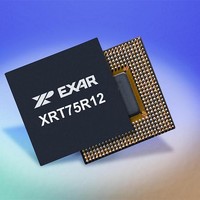XRT75R12DIB-F Exar Corporation, XRT75R12DIB-F Datasheet - Page 108

XRT75R12DIB-F
Manufacturer Part Number
XRT75R12DIB-F
Description
Peripheral Drivers & Components (PCIs) 12 Channel 3.3V-5V temp -45 to 85C
Manufacturer
Exar Corporation
Datasheet
1.XRT75R12DIB-F.pdf
(133 pages)
Specifications of XRT75R12DIB-F
Maximum Operating Temperature
+ 85 C
Minimum Operating Temperature
- 40 C
Mounting Style
SMD/SMT
Operating Supply Voltage
3.3 V to 5 V
Package / Case
TBGA-420
Lead Free Status / RoHS Status
Lead free / RoHS Compliant
- Current page: 108 of 133
- Download datasheet (851Kb)
XRT75R12D
TWELVE CHANNEL E3/DS3/STS-1 LINE INTERFACE UNIT WITH SONET DESYNCHRONIZER
In the "Slip Buffer, the "input" STS-1 data (labeled "STS-1 Data_IN") is latched into the FIFO, upon a given
edge of the corresponding "STS-1 Clock_f1" input clock signal. The STS-1 Data (labeled "STS-1 Data_OUT")
is clocked out of the Slip Buffer upon a given edge of the "STS-1 Clock_f2" input clock signal.
The behavior of the data, passing through the "Slip Buffer" is now described for each possible relationship
between frequencies f1 and f2.
If f1 = f2
If both frequencies, f1 and f2 are exactly equal, then the STS-1 data will be "clocked" into the "Slip Buffer" at
exactly the same rate that it is "clocked out". In this case, the "Slip Buffer" will neither fill-up nor become
depleted. As a consequence, no pointer-adjustments will occur in this STS-1 data stream. In other words, the
STS-1 SPE will remain at a constant location (or offset) within each STS-1 envelope capacity for the duration
that this STS-1 signal is supporting this particular service.
If f1 < f2
If frequency f1 is less than f2, then this means that the STS-1 data is being "clocked out" of the "Slip Buffer" at
a faster rate than it is being clocked in. In this case, the "Slip Buffer" will eventually become depleted.
Whenever this occurs, a typical strategy is to "stuff" (or insert) a "dummy byte" into the data stream. The
purpose of stuffing this "dummy byte" is to compensate for the frequency differences between f1 and f2, and
attempt to keep the "Slip Buffer, at a somewhat constant fill level.
N
Since this "dummy byte" carries no useful information, it is important that the "Receiving PTE" be notified
anytime this "dummy byte" stuffing occurs. This way, the Receiving Terminal can "know" not to treat this
"dummy byte" as user data.
Byte-Stuffing and Pointer Incrementing in a SONET Network
Whenever this "byte-stuffing" occurs then the following other things occur within the STS-1 data stream.
During the STS-1 frame that contains the "Byte-Stuffing" event
F
a. The "stuff-byte" will be inserted into the byte position immediately after the H3 byte. This insertion of the
OTE
IGURE
"dummy byte" immediately after the H3 byte position will cause the J1 byte (and in-turn, the rest of the
SPE) to be "byte-shifted" away from the H3 byte. As a consequence, the offset between the H3 byte posi-
tion and the STS-1 SPE will now have been increased by 1 byte.
: This "dummy byte" does not carry any valuable information (not for the user, nor for the system).
51. A
N
I
LLUSTRATION OF AN
STS-1 Clock_f1
STS-1 Data_IN
Clock Domain operating
At frequency f1
STS-1
SIGNAL BEING PROCESSED VIA A
SLIP BUFFER
SLIP BUFFER
104
Clock Domain operating
At Frequency f2.
S
LIP
STS-1 Data_OUT
STS-1 Clock_f2
B
UFFER
REV. 1.0.3
Related parts for XRT75R12DIB-F
Image
Part Number
Description
Manufacturer
Datasheet
Request
R

Part Number:
Description:
Twelve Channel E3/ds3/sts-1 Line Interface Unit With Jitter
Manufacturer:
Exar Corporation
Datasheet:

Part Number:
Description:
BiCMOS Fixed, Quad, Voltage Output, Single or Dual Supply 8-Bit Digital-to-Analog Converter
Manufacturer:
Exar Corporation
Datasheet:

Part Number:
Description:
Manufacturer:
Exar Corporation
Datasheet:

Part Number:
Description:
Voltage-Controlled Oscillator
Manufacturer:
Exar Corporation
Datasheet:

Part Number:
Description:
INTEGRATED LINE TRANSMITTER
Manufacturer:
Exar Corporation
Datasheet:

Part Number:
Description:
Monolithic Function Generator
Manufacturer:
Exar Corporation
Datasheet:

Part Number:
Description:
CMOS Microprocessor Compatible Double-Buffered 12-Bit Digital-to-Analog Converter
Manufacturer:
Exar Corporation
Datasheet:

Part Number:
Description:
CMOS 6 BIT HIGH SPEED ANALOG TO DIGITAL CONVERTER
Manufacturer:
Exar Corporation
Datasheet:

Part Number:
Description:
Manufacturer:
Exar Corporation
Datasheet:

Part Number:
Description:
Manufacturer:
Exar Corporation
Datasheet:

Part Number:
Description:
8-Channel, Voltage Output 10 MHz Input Bandwidth 8-Bit Multiplying DACs with Serial Digital Data Por
Manufacturer:
Exar Corporation
Datasheet:

Part Number:
Description:
15 V CMOS Multiplying10-Bit Digital-to-Analog Converter
Manufacturer:
Exar Corporation
Datasheet:

Part Number:
Description:
Monolithic Function Generator
Manufacturer:
Exar Corporation
Datasheet:










